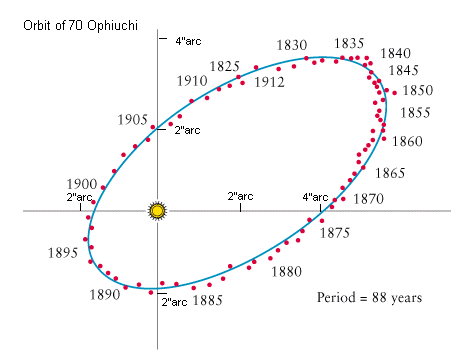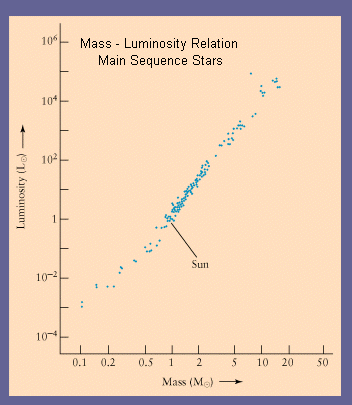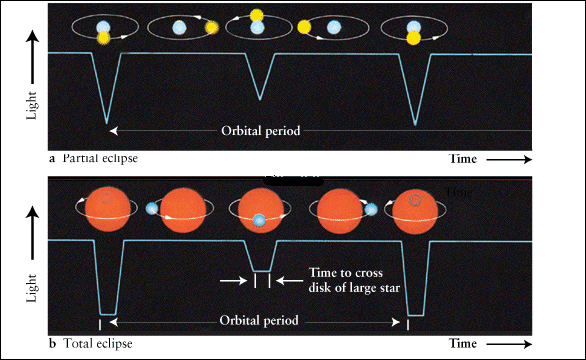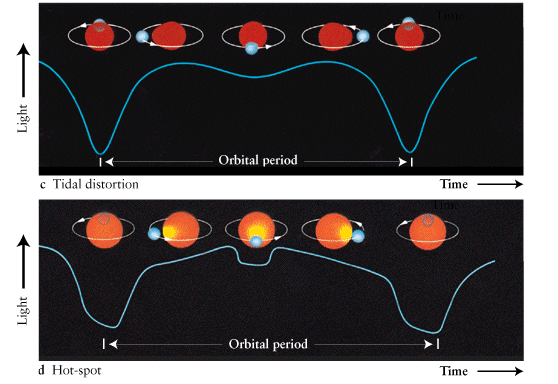Astronomy 2 - Lecture Notes
Stellar Mass, Binary Stars and Star Clusters
Astronomical Events:
Sky - View South - ECU
Location of the largest asteroid
Sunday:New Moon
Monday-Tuesday: Cresent Moon near Venus at Sunset
You should be finished reading Chapter 17, Start Chapter 18 for Wednesday
------
Quiz today:
1. What two quantities must be known about a star to determine its
radius indirectly?
2.Which type star is the most common in the Galaxy?
Why don't we see many of them in the H-R diagrams?
Subject Matter Today:
- Bolometric Magnitude, MB, BC, CI, and Teff
- Visual Binaries, Orbits and Mass Determination
- Spectrosopic Binaries and Orbits
- Eclipsing Binaries, Light Curves and Stellar Radii
- Mass - Luminosity Relationship
- Lifetime of Stars
- HR Diagram and Star Clusters
Luminosity Classes:
(Table 17.3)
Example of T=4000 K
Ia - Bright Super Giants
Ib - Supergiants L = 3000 R = 100
II - Bright Giants
III - Giants L = 20 R = 20
IV - Subgiants
V - Main Sequence/Dwarf stars L = 0.1 R = 0.7
Spectrum of two B8 Stars:
Rigel (L = 58,000 Ls)
Algol (L = 100 Ls)
 Note the difference in the width of the spectral lines
for the same spectral class. These stars have different
luminosity class. Algol is smaller and denser and its
lines are broadened by pressure.
Note the difference in the width of the spectral lines
for the same spectral class. These stars have different
luminosity class. Algol is smaller and denser and its
lines are broadened by pressure.
Bolometeric Magnitude
MV = absolute visual magnitude and does not include
all the radiation from the star and corresponds to a
luminosity less than the total of all radiation.
Mbol = absolute bolometric magnitude is derived from
the luminosity of the star that includes all the
radiation L ~ R2 T4
Mbol = MV + BC where BC = Bolometric Correction
BC depends on the Temperature of the stars photosphere
Main Sequence and Java Script Calculator for MB
Examples:
Sun B8 star
T 5780 K 15000 K
B-V 0.69 -0.171
BC 1.79 -1.31
MV 4.93 -0.46
Mbol 4.75 -1.77
Use Mbol to calculate Radius not MV
Binary Stars:
Visual Binaries
1827: First binary star measured, xi Ursae Majoris
1844: Bessel saw wavy motion of Sirius (alpha Canis Majoris)
1862: Alvin Clark saw Sirius B with his new refracting lens.
Measured - separation (" arc)
position angle (N to E)
Instrument (visual - filar micrometer)
(photographic + microsope)
(CCD + SAO Image program)
Plot versus time, eg. 70 Ophiuchi
mA = 4.2 mB = 6.0 pa = 151 sep = 3.5"arc
Period = 88 years (same position as 1910)
 Problems: Projection onto the sky, not true orbit
Have to find inclination of orbit to line of sight
Problems: Projection onto the sky, not true orbit
Have to find inclination of orbit to line of sight
Astro-mechanics of Binary Stars
Kepler's 3rd Law
P2 =a3/(MA+MB)
a in AU
P in years
M, mass in solar Masses
Centre of Mass
Note that only the sum of the masses may be determined from the period
and the separation of the stars.
In order to deduce the individual masses we must know the
center of mass of the system. This can be determined only
if the absolute mostion of the individual stars is measured.
if rA and rB are the respective distance of stars A and B from
the center of mass then:
MA rA = MB rB
EXAMPLE
Sirius - alpha Canis Majoris
Binary System
mA = -1.5
mB = 8.5 (very dim relative to A)
sep = 4.3"
pa = 162o
- Period = 50.1 years
- Epoch of Apastron = 1894, 1944, 1994
- eccentricity = 0.59
- semi-major axis = 7.5"arc
- inclination of orbit = 136o
- Distance = 2.7 pc
a(AU) = angle(radian) x distance(AU)
a = [7.5"/(206,300"/radian)] x [2.7pc x 206,300 AU/pc]
a = 7.5" x 2.7pc = 20.3 AU
(MA+MB)= a3/P2
(MA+MB)= (20.3)3/(50.1)2 = 3.33 Msun
The motion of A and B have been measured relative to the center of mass
- rB/rA = 5/2
so
- MA/MB = 5/2
- (5/2 + 1)MB = 3.33 Ms
- MB = 0.96 Ms
and
- MA = 5/2(0.96)Ms = 2.4 Ms
|
We can only get the sum of the masses
If we did not know the inclination we could only get the mass and inclinatio combined.
But the inclination may be deduced by using Kepler's laws on the full orbit motion.
Spectroscopic Binary Stars
Each star is in motion about the other and the velocity
produce a doppler shift in the spectrum that has a
period equal to the period of rotation.
Double line spectrum. As one star is moving away another is
moving towards us. This give a double line doppler shifted
spectrum. (See figure below)
 Example:
Single Line Spectroscopic systms
Many spectroscopic binary have only one star bright enough
to produce a spectrum and then we only see one line shifting
back and forth between red and blue shift - We can get the
period and velocity of one star.
Example:
Single Line Spectroscopic systms
Many spectroscopic binary have only one star bright enough
to produce a spectrum and then we only see one line shifting
back and forth between red and blue shift - We can get the
period and velocity of one star.
Mass Luminosity Relation
After many star masses have been measured a graph can be
made of the masses versus the brightness of the stars.
This produces a mass-luminosity relation for Main Sequence
stars - but not other luminosity classes
 The relation can be approximated by the formula:
L/Ls = (M/Ms)n
The value of n = 3 to 4 with an average of 3.5.
Most references use n = 3.5 but Chaisson and MacMillan use n = 3.
EXAMPLE:
Sirius A has a luminosity about 100 Ls
which would mean that it has a mass of (L/Ls)2/7Ms
= 1002/7 Ms = 3.7 Ms
(A bit bigger than the actual value found from its binary system)
Lifetime of a Star
The rate with which a star uses up its energy (and hence mass)
is proportional to its luminosity so its lifetime will be
proportional its mass and inversely proportional to its
luminosity.
lifetime ~ mass/luminosity
But since L ~ M3.5 we can see that
lifetime ~ M/M3.5 = 1/M2.5
This gives the surprising result that
MORE MASSIVE STARS HAVE SHORTER LIFETIMES.
Since the Sun is known to have a lifetime of 10 billion years
we can form an equality for main sequence stars.
lifetime = 1010 yr x (Ms/M)2.5
Example:
Massive Star, M = 10 Ms
lifetime = (10 billion yrs)/102.5 = 31 million years
Two solar Mass Star
lifetime = (10 billion yrs)/22.5 = 1.8 billion years
Red Dwarf Star M = 0.1 Ms
lifetime = (10 billion yrs)/(0.1)2.5 = 3.2 trillion years
We see that a small change in mass makes a dramatic change in lifetime.
The relation can be approximated by the formula:
L/Ls = (M/Ms)n
The value of n = 3 to 4 with an average of 3.5.
Most references use n = 3.5 but Chaisson and MacMillan use n = 3.
EXAMPLE:
Sirius A has a luminosity about 100 Ls
which would mean that it has a mass of (L/Ls)2/7Ms
= 1002/7 Ms = 3.7 Ms
(A bit bigger than the actual value found from its binary system)
Lifetime of a Star
The rate with which a star uses up its energy (and hence mass)
is proportional to its luminosity so its lifetime will be
proportional its mass and inversely proportional to its
luminosity.
lifetime ~ mass/luminosity
But since L ~ M3.5 we can see that
lifetime ~ M/M3.5 = 1/M2.5
This gives the surprising result that
MORE MASSIVE STARS HAVE SHORTER LIFETIMES.
Since the Sun is known to have a lifetime of 10 billion years
we can form an equality for main sequence stars.
lifetime = 1010 yr x (Ms/M)2.5
Example:
Massive Star, M = 10 Ms
lifetime = (10 billion yrs)/102.5 = 31 million years
Two solar Mass Star
lifetime = (10 billion yrs)/22.5 = 1.8 billion years
Red Dwarf Star M = 0.1 Ms
lifetime = (10 billion yrs)/(0.1)2.5 = 3.2 trillion years
We see that a small change in mass makes a dramatic change in lifetime.
Eclipsing Binaries
There can be partial or total eclipse of the stars.
The size of the stars effect the light curve of
the stars and the light curve can be used to determine
the sizes.
 If the stars are very close binary stars,
with separations comparable to the size of
the star then the effects of tidal distortion
and mutual heating can be seen in the light curve.
If the stars are very close binary stars,
with separations comparable to the size of
the star then the effects of tidal distortion
and mutual heating can be seen in the light curve.
 A very special eclipsing binaries:
Visible short period: beta Persei, Algol
Supergiant system: beta Lyrae
A very special eclipsing binaries:
Visible short period: beta Persei, Algol
Supergiant system: beta Lyrae
 Note the difference in the width of the spectral lines
for the same spectral class. These stars have different
luminosity class. Algol is smaller and denser and its
lines are broadened by pressure.
Note the difference in the width of the spectral lines
for the same spectral class. These stars have different
luminosity class. Algol is smaller and denser and its
lines are broadened by pressure.
 Problems: Projection onto the sky, not true orbit
Have to find inclination of orbit to line of sight
Problems: Projection onto the sky, not true orbit
Have to find inclination of orbit to line of sight
 Example:
Single Line Spectroscopic systms
Many spectroscopic binary have only one star bright enough
to produce a spectrum and then we only see one line shifting
back and forth between red and blue shift - We can get the
period and velocity of one star.
Example:
Single Line Spectroscopic systms
Many spectroscopic binary have only one star bright enough
to produce a spectrum and then we only see one line shifting
back and forth between red and blue shift - We can get the
period and velocity of one star.
 The relation can be approximated by the formula:
L/Ls = (M/Ms)n
The value of n = 3 to 4 with an average of 3.5.
Most references use n = 3.5 but Chaisson and MacMillan use n = 3.
EXAMPLE:
Sirius A has a luminosity about 100 Ls
which would mean that it has a mass of (L/Ls)2/7Ms
= 1002/7 Ms = 3.7 Ms
(A bit bigger than the actual value found from its binary system)
Lifetime of a Star
The rate with which a star uses up its energy (and hence mass)
is proportional to its luminosity so its lifetime will be
proportional its mass and inversely proportional to its
luminosity.
lifetime ~ mass/luminosity
But since L ~ M3.5 we can see that
lifetime ~ M/M3.5 = 1/M2.5
This gives the surprising result that
MORE MASSIVE STARS HAVE SHORTER LIFETIMES.
Since the Sun is known to have a lifetime of 10 billion years
we can form an equality for main sequence stars.
lifetime = 1010 yr x (Ms/M)2.5
Example:
Massive Star, M = 10 Ms
lifetime = (10 billion yrs)/102.5 = 31 million years
Two solar Mass Star
lifetime = (10 billion yrs)/22.5 = 1.8 billion years
Red Dwarf Star M = 0.1 Ms
lifetime = (10 billion yrs)/(0.1)2.5 = 3.2 trillion years
We see that a small change in mass makes a dramatic change in lifetime.
The relation can be approximated by the formula:
L/Ls = (M/Ms)n
The value of n = 3 to 4 with an average of 3.5.
Most references use n = 3.5 but Chaisson and MacMillan use n = 3.
EXAMPLE:
Sirius A has a luminosity about 100 Ls
which would mean that it has a mass of (L/Ls)2/7Ms
= 1002/7 Ms = 3.7 Ms
(A bit bigger than the actual value found from its binary system)
Lifetime of a Star
The rate with which a star uses up its energy (and hence mass)
is proportional to its luminosity so its lifetime will be
proportional its mass and inversely proportional to its
luminosity.
lifetime ~ mass/luminosity
But since L ~ M3.5 we can see that
lifetime ~ M/M3.5 = 1/M2.5
This gives the surprising result that
MORE MASSIVE STARS HAVE SHORTER LIFETIMES.
Since the Sun is known to have a lifetime of 10 billion years
we can form an equality for main sequence stars.
lifetime = 1010 yr x (Ms/M)2.5
Example:
Massive Star, M = 10 Ms
lifetime = (10 billion yrs)/102.5 = 31 million years
Two solar Mass Star
lifetime = (10 billion yrs)/22.5 = 1.8 billion years
Red Dwarf Star M = 0.1 Ms
lifetime = (10 billion yrs)/(0.1)2.5 = 3.2 trillion years
We see that a small change in mass makes a dramatic change in lifetime.
 If the stars are very close binary stars,
with separations comparable to the size of
the star then the effects of tidal distortion
and mutual heating can be seen in the light curve.
If the stars are very close binary stars,
with separations comparable to the size of
the star then the effects of tidal distortion
and mutual heating can be seen in the light curve.
 A very special eclipsing binaries:
Visible short period: beta Persei, Algol
Supergiant system: beta Lyrae
A very special eclipsing binaries:
Visible short period: beta Persei, Algol
Supergiant system: beta Lyrae